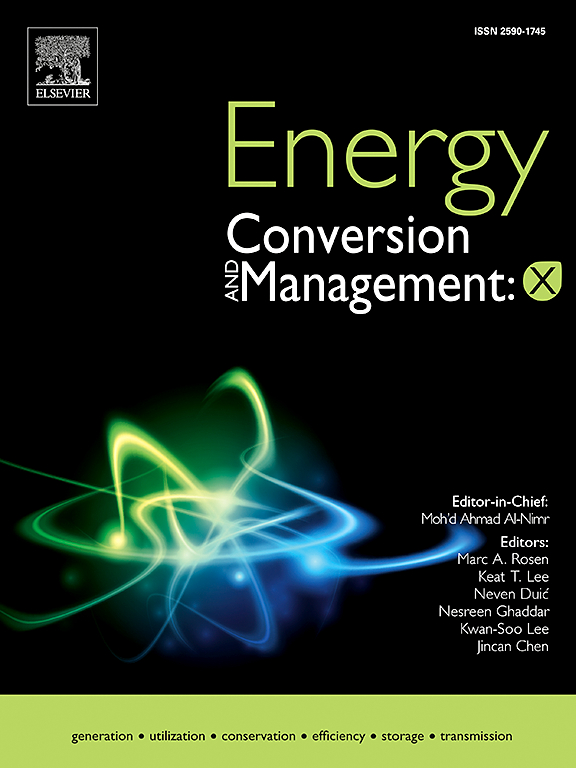结合氨分解、质子交换膜燃料电池和微型燃气轮机的高效氨燃料混合发电系统:热力学模型及性能优化
IF 9.9
1区 工程技术
Q1 ENERGY & FUELS
引用次数: 0
摘要
氨(NH3)作为一种无碳的氢(H2)载体,具有液化储运的优势,被认为是生产和发电中具有竞争力的清洁能源载体。本文设计了一种氨分解反应器(ADR)、质子交换膜燃料电池(PEMFC)和微型燃气轮机(MGT)与ADR热化学回收相结合的新型氨燃料混合发电系统。建立了一个系统级热力学模型来评价不同优化策略下的系统性能。模型计算表明,NH3分解温度从500℃降至350℃,可使能源效率从33.5%提高到43.2%,因此提出了两种改进的集成策略。将部分NH3与PEMFC阳极废气混合用于MGT燃料,可以减少NH3的分解需求,更好地利用MGT的余热。将ADR与MGT燃烧室相结合,可以降低高温NH3分解催化剂的废气温度和效率损失。当NH3分解温度为500℃和350℃时,这两种策略都能提高系统的能效,分别达到40%和44%左右,并且对NH3分解温度的变化具有更好的适应性。本文章由计算机程序翻译,如有差异,请以英文原文为准。
High-efficiency ammonia-fueled hybrid power generation system combining ammonia decomposition, proton exchange membrane fuel cell and micro gas turbine: A thermodynamic model and performance optimization
As a carbon-free hydrogen (H2 ) carrier with the advantage of liquefaction storage and transportation, ammonia (NH3 ) is regarded as a competitive clean energy carrier for H2 production and power generation. This work designs a novel NH3 -fueled hybrid power generation system, which combines ammonia decomposition reactor (ADR), proton exchange membrane fuel cell (PEMFC) and micro gas turbine (MGT) together with thermochemical recuperation for ADR. A system-level thermodynamic model has been developed to evaluate system performance with different optimization strategies. The model calculation reveals that the NH3 decomposition temperature drop from 500 °C to 350 °C can increase the energy efficiency from 33.5 % to 43.2 %, and two improved integration strategies have therefore been proposed. Mixing a part of NH3 with the exhaust gas from PEMFC anode to fuel MGT can reduce the NH3 decomposition demand and makes better use of waste heat from MGT. Integrating ADR with MGT combustor can lower the exhaust gas temperature and the efficiency loss when using high temperature NH3 decomposition catalyst. Both strategies can improve the system energy efficiency, to about 40 % and 44 % when NH3 decomposition temperature is 500 °C and 350 °C, respectively, and demonstrate better flexibility in adapting to changes in NH3 decomposition temperature.
求助全文
通过发布文献求助,成功后即可免费获取论文全文。
去求助
来源期刊

Energy Conversion and Management
工程技术-力学
CiteScore
19.00
自引率
11.50%
发文量
1304
审稿时长
17 days
期刊介绍:
The journal Energy Conversion and Management provides a forum for publishing original contributions and comprehensive technical review articles of interdisciplinary and original research on all important energy topics.
The topics considered include energy generation, utilization, conversion, storage, transmission, conservation, management and sustainability. These topics typically involve various types of energy such as mechanical, thermal, nuclear, chemical, electromagnetic, magnetic and electric. These energy types cover all known energy resources, including renewable resources (e.g., solar, bio, hydro, wind, geothermal and ocean energy), fossil fuels and nuclear resources.
 求助内容:
求助内容: 应助结果提醒方式:
应助结果提醒方式:


